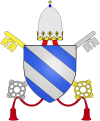Pope Adrian V
Pope Adrian V (Latin: Adrianus V; c. 1210/1220 – 18 August 1276), born Ottobuono de' Fieschi,[1] was Pope from 11 July 1276 to his death on 18 August 1276.
Pope Adrian V | |
|---|---|
| Bishop of Rome | |
| Papacy began | 11 July 1276 |
| Papacy ended | 18 August 1276 |
| Predecessor | Innocent V |
| Successor | John XXI |
| Orders | |
| Created cardinal | December 1251 by Innocent IV |
| Personal details | |
| Birth name | Ottobuono de' Fieschi |
| Born | c. 1210–1220 Genoa, Republic of Genoa |
| Died | 18 August 1276 Viterbo, Papal States |
| Previous post |
|
| Coat of arms |  |
| Other popes named Adrian | |

Biography
Ottobuono belonged to a feudal family of Liguria, the Fieschi, Counts of Lavagna. His first clerical position came in 1243, when he was created a papal chaplain. Subsequently, he received several ecclesiastical benefices, becoming archdeacon in Bologna (1244) and Parma (1244/48–1255), canon and chancellor of the cathedral chapter in Reims (1243–1250), canon and dean of the chapter in Piacenza (c. 1247) and canon of the cathedral chapter in Paris (1244/45–1270). In December 1251, he was created Cardinal Deacon of San Adriano by his uncle Pope Innocent IV. He was also archpriest of the patriarchal Liberian Basilica (attested from 1262).
He was sent to England in 1265 by Pope Clement IV to mediate between King Henry III of England and his barons,[2] and to preach the Crusades. Fieschi was related distantly, by affinity, to Henry III; his sister had married Thomas II of Savoy, who was a cousin of Henry's wife, Eleanor of Provence.[3]
He remained in England for several years as the papal legate, serving from October 1265 to July 1268. His diplomatic position was such that his name is still on the oldest extant piece of English statute law, the Statute of Marlborough of 1267, where the formal title mentions as a witness "the Lord Ottobon, at that time legate in England". (Also on this legation was a young diplomat, the future Boniface VIII.) In April 1268 he issued a set of canons, which formed the basis of church law in England until the Protestant Reformation of the sixteenth century.
Under the influence of Charles of Anjou, he was elected Pope to succeed Innocent V on 11 July 1276 but died at Viterbo on 18 August 1276 from illness without ever having been ordained to the priesthood.[4] He is buried there in the church of San Francesco alla Rocca. His funeral monument is attributed to Arnolfo di Cambio. Adrian V was the third pope in the "Year of Four Popes" of 1276.
He annulled Pope Gregory X's bull on the holding of papal conclaves, but died before enacting new regulations.[2]
In literature
In the Divine Comedy, Dante meets Adrian's spirit in Purgatory, on the level reserved for the avaricious, where Adrian atones for his sin of worldly ambition. (Purgatorio XIX, 88-145).
See also
References
- Alban Butler and Paul Burns, Butler's Lives of the Saints, Vol. 9, (Burns & Oates, 2000), 131.
- Loughlin, James. "Pope Adrian V." The Catholic Encyclopedia Vol. 1. New York: Robert Appleton Company, 1907. 4 January 2020

- Howell, Margaret (1998). "Eleanor of Provence: Queenship in 13th Century England", p. 154. Blackwell Publishing, Malden Massachusetts. ISBN 0-631-17286-6
-

Bibliography
- Herbermann, Charles, ed. (1913). . Catholic Encyclopedia. New York: Robert Appleton Company.
- Cristofori, Francesco (1887). Le tombe dei pape in Viterbo. Siena 1887.
- Sternfeld, Richard (1905). Der Kardinal Johann Gaetan Orsini (Papst Nikolaus III.) 1244-1277. Berlin: E. Ebering 1905.
- Gregorovius, Ferdinand (1906). History of Rome in the Middle Ages, Volume V.2 second edition, revised. London: George Bell, 1906.
- Schöpp, Natalie (1916). Papst Hadrian V (Kardinal Ottobuono Fieschi). Heidelberg; C. Winter 1916.
- Gatto, Ludovico (2000). "Adriano V," Enciclopedia dei papi (ed. Manlio Simonetti et al.) Vol. I (Roma 2000), pp. 425–427.
- Maxwell-Stuart, P. G. Chronicle of the Popes: The Reign-by-Reign Record of the Papacy from St. Peter to the Present. New York: Thames & Hudson, 2002, pp. 117–118. ISBN 0-500-01798-0.
- Paravicini Bagliani, A. (1972). Cardinali di curia e familiae cardinalizie dal 1227 al 1254, Padova 1972, pp. 358–365
- Bolton, Brenda M. (2004). "Ottobuono [Ottobuono or Ottobono Fieschi; later Adrian V] (c.1205–1276)". Oxford Dictionary of National Biography (online ed.). Oxford University Press. doi:10.1093/ref:odnb/50348. (Subscription or UK public library membership required.)
| Catholic Church titles | ||
|---|---|---|
| Preceded by Innocent V |
Pope 1276 |
Succeeded by John XXI |